Before the 2012 New York Asian Film Festival crashed the summer, bringing with it Choi Min-Sik and an impressive host of his movies, a concept was established: The Violent Eye Party. While none too clearly defined, here are some of its proposed tenets:
- movies from the back catalogue watched in marathon-like progression.
- movies picked, ahem “curated,” by one of the Violent Eye’s rotating collective, with a theme in mind,and if possible, an international scope.
- comparisons, connections welcomely explored.
- focus on and appreciation for portrayals of violence in movies, primarily (for the time being at least) Asian.
This is a report on the first Violent Eye event, which took place before attention and activity turned to Choi-Min Sik’s films and his appearance at NYAFF 2012.
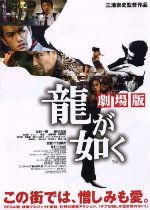
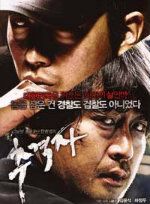

This first set of movies was the preferred triple feature programmed by the Violent Eye’s resident conduit to the physical world, Mondocurry. Its theme, or at least attempted theme, was one on one showdowns. The movies shown were LIKE A DRAGON (2007), THE CHASER (2008), and DOG BITE DOG (2006). They came from Japan, South Korea, and Hong Kong respectively.
If there was anything that proposed a challenge to the theme (hence the ‘attempted’ remark earlier) it’s Japanese cinema. The genre pool is filled with movies flying the masts of horror, sexploitation, and Yakuza (gangster) dramas. The last of these was surely the most promising to select from, but mostly involve drama and to-be-expected complex interactions between various characters of different rank and gang affiliation. Fight choreography is often a minor feature. (Should you, reader, have any fitting suggestions you feel was missed, please do share them). And so came about the odd choice of LIKE A DRAGON, a Takashi Miike adaptation of a Yakuza themed video game. That Miike’s name came up is no surprise, as he seems a director most readily associated with contemporary Yakuza themed action films. One of the considerations for a different Japanese film was one of the three parts in the quite uneven Dead Or Alive trilogy, which he also directed.
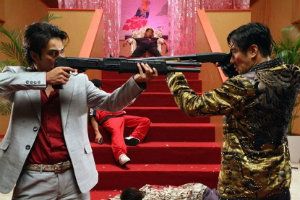
Yes, LIKE A DRAGON did promise a showdown: On one side, recently released from prison gangster with a heart of gold, Kiryu Kazuma, and opposite him, erratically behaving gang boss Majima Goro, whose knowledge of Kazuma’s release registers a remembrance of some kind of grudge that bears repaying without wasting a single minute. Before you strap yourself in for a fast-paced back and forth battle, know that this situation is surrounded by at least four others (some connected and some not), and bounces between them with a severe case of attention deficit disorder.
The fights between Kazuma and Majima are frenetic, but bear a tone of silliness. Perhaps owing to being in “video game mode,” Miike chooses to embellish battles with cartoonish effects (fast spinning bats, neon electric charged “power up” punches). It does make for some fun. Majima is quite a colorful caricature of a villain, patch on one eye, carrying a golden baseball bat which he uses to bash away liberally at rival gang members and one of his own lackeys. The Warriors-inspired concept is taken to cartoonish heights as Majima tosses baseballs into the air only to smack them at the targeted heads and abdomens of his opponents. As conclusions draw near, a hotel battle between the two finds Majima batting baseballs that ricochet from wall to wall at an angered Kazuma. With Majima, Miike also takes a page from “exhaustion action” trends, with the patch-eyed slugger fairing worse for wear in all of his battles with Kazuma across a neon imbued Tokyo; yet, he continues to drag himself off the floor and stagger to the next battle. Meanwhile Kazuma is all righteous indignation-fueled strength that has him convincingly (with a little suspension of disbelief) fending off hordes of gang members singlehandedly.
Whatever the source of their beef, the battles between the two never go beyond surface level aggression. As for the other goings ons, they range from a pair of incompetent robbers holed up with their hostages in a bank, a girl and boy on an impromptu crime spree with an incident from the girl’s past looming over their heads, and a Korean assassin who is targeting a major criminal organization for unclear reasons. Meanwhile, when not fending off Majima’s attacks, Kazuma is helping a little girl to find her mother who is somehow wrapped up in said organization. Miike successfully creates an atmosphere where an Indian summer has everyone itching and squirming and making rash decisions under the pressure of the heat. But all these loose threads hardly come together into one coherent package. The ending explosion leaves a giant question mark hanging in the air. It may be a successful adaptation of a video game, but its way of operating does not come close to translating into narrative logic. Along the way are some other hallmarks of the typical Miike-helmed Yakuza film that make this fail to stand out from the rest of the pack. One is the inclusion of 80s-like squalling guitar solos throughout the movie. For whatever reason, Miike has chosen this many times over as the sound of modern gang conflict suspense. To me, it is more of a distraction than a mood builder. While the movie does take some impressive strides toward combining intense action sequences with a gang related drama, it draws attention to a definite demand for new voices calling from the director’s chair to add some diversity and maybe even a little one upmanship into this genre.
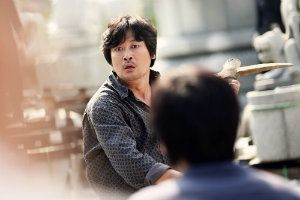
Considering the order the movies were watched in, having THE CHASER in the middle position, we could liken it to the main course. It fit exactly what was being sought: a story of two individuals trying desperately to destroy one another. The mood is consistently grim as director Na Hong-Jin unfolds a tale of bad vs. worse -- a disgraced cop turned prostitute tracks down a trail of missing prostitutes to a detached serial killer. The pimp, Joong-ho is as reluctant a hero (if such a term can even be used) as one could find; his attitude about the girls’ disappearance is filled with cynicism, at first insisting that the missing girls had run off with money he is due. When the truth comes to light, his drive to take down the elusive Yong-min stems from a combination of seeking comeuppance for trouble caused, the slight bit of redemption that will come from saving the last girl to disappear with the murderer, and sheer stubbornness in the face of a police force who are tied up in political games to the point of complete inefficiency.
The story is more about Jong Ho and a dysfunctional police force’s pursuit of Yong-min, while meanwhile, he wants primarily to escape and continue his murderous ways. Their final exchange is a nasty,artless tumble, including attacks with a hammer and chisel and bodies hurled into fish tanks. Leading up to it is an awkward suspense of missed opportunities and local naiveties that conspire together to make Murphy’s law that anything that could go wrong will go wrong come to life. It not only kicks, but stomps down repeatedly on the audience’s gut.
Characteristic of many dark Korean films is a strong voice of social commentary and the ability to summon gallows humor in the midst of even the most terrible situations. A running gag on cell phone tags leads to the ensnared prostitute’s daughter referring to -- as he is labeled in its memory: filth. What stands out in this all around masterful first feature for the director is the dynamic between Jung-ho and Yong-min. Jung-ho is all red hot rage and bluster to Yong-min‘s ice cold, near impenetrable demeanor.
The two leads, Yun-seok Kim and Jung-woo Ha would later trade roles of vice and relative virtue, appearing opposite one another in Na Hong-jin’s second feature, The Yellow Sea. While a less perhaps a less perfect battle than the one found in CHASER, that film’s scenario of an individual brought into a metropolis from a nearby economically disadvantaged country, thereby wreaking havok on, and in effect destabilizing a more advanced yet corrupt society mirrors what happens in our third feature, DOG BITE DOG (directed by Pou-Soi Cheang).
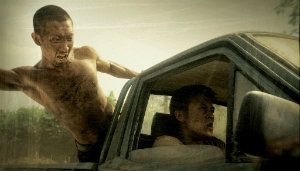
In an alternate universe of my devising, instead of being famous for a computer filled with photos of sexual exploits, lead Edison Chen would be most recognized for his ultra aggressive turn in this film. He truly captures the essence of the mad dog killing machine archetype. In one very quick and efficient setup, we find Pang (Chen’s assassin) whisked across the sea from Cambodia towards a high society target whom he instructed to put a bullet or two into. In a fast and bloody scene of jolting adrenaline, he dispenses with his (somewhat disturbingly) elderly victim, turning his attention thereafter to evading the local cops and making his way back overseas. His every action is about survival -- from using his hand to shovel handfuls of food into his mouth to pushing back the police using hostages whose lives only last as long as it takes him to grab the next one. In keeping with the tradition of its Hong Kong action predecessors, the story does not dwell much on plot intricacies. Little is made of the reason for the contract killing. Rather, we follow the fugitive as he escapes to a junkyard of fetid towering heaps of trash where he finds a girl living a secluded life of abuse at the hands of a repugnant father figure. Pang frees her from this reality making the two allies in a bid to escape to a Cambodia that now seems less savage than Hong Kong with its corruption and people abusing power. From here, instead of worrying only about himself, he has a vested interest in protecting this girl, who in turn becomes something of a leverage point for the cops in pursuit.
The assassins nemesis comes in the unlikely form of Sam Lee (an actor who appears in many actions films, but rarely as the lead) who plays Inspector Ti Wai. The combination of family drama in the background -- his father, a troubling combination of inspiration and disappointment having been charged with drug related corruption is hospitalized -- and the cold blooded efficiency with which his comrades are maimed or killed leads the young police officer on an obsessive course towards bringing in the killer or annihilating him in the process.
There is a point in the film where it could have ended somewhat elegantly and with a contemplative image left to sink into our consciences, if not in the most conclusive fashion. However the film insists on going forward, beyond restraint or good taste. Like the film’s introduction, a flash forward to Cambodia begins and speeds through significant events like a ticking bomb is strapped to its back. The couple, thrown together by a struggle-filled fate,settle down with an expected child and a life free of violence. Then, in a move that is just shy of defying time and space, Detective --- appears, transformed, having put himself through the trials of a brutal underground fighting ring. Things spiral quickly into a violent climax with a tragic turn of events.
The film does leave us with a final, striking image but this one is meant to shatter. Like in CHASER, the intent is to leave jaws dropped and emotions drained. It may have done so more effectively if the final stretch was not so far fetched a turn of events, but the Cambodia sent the movie straight over the rainbow. Even sonically...In the background of the final battle (taking place among beautiful temple ruins) a syrupy rendition of the song ‘Somewhere Over the Rainbow’ plays, which sent the New York Asian Film Festival audience with whom I first watched it into unintended fits of laughter. It clearly did not have the intended dramatic effect on Western audiences who are too familiar with the tune. Beyond that, the director was trying to make a grand statement but it ended up as overkill, since the images of what happened were sufficient enough in driving its message of cyclical violence home. This film has some of the most tightly wound fast paced action sequences around. It could have gone down as a tight suspenseful exercise in violence, and for most of the film it functions as just that. But the over the top ending will probably have it going down in most memories as an overblown attempt at social commentary.
While South Korean and Hong Kong cinema both have a wealth of talent dedicated to portraying physical action, Japanese productions don’t offer it as much or perhaps there is just more interest within the serious film market in horror and drama. Most of the Japanese movies that come to mind with a major focus on action are from Miike and Nishimura Yoshihiro. Both make movies that contain varying degrees of cartoonish elements. While genre director Ryuhei Kitamura comes to mind (with a movie that is perfectly titled VERSUS!) his work was usually centered around science fiction or fantasy and delivered action, but with very little that could be taken seriously beyond the choreography. While this installment’s Hong Kong representative has thrilling action, it was not presented in a way that was conducive to serious consideration of society’s ills. Finally, the South Korean film combined intense action between two compelling individuals with a story that drags several aspects of society through the mud. It’s a film that is hard to watch without feeling devastated afterwards.
Winner? THE CHASER
Some acknowledgments:
Unseen Films for inspiring me to document my impressions on film and providing me with a respectable home from which to do so.
Planet Chocko Zine with its intensive reporting on all things rising up from the underground, including (but not limited to) films, music, art, and whose cast of characters throw their support and hats in the ring for intense screening marathons like this one.
CineAwesome whose cleverly titled podcasts on genre film double features are filled with witty banter and an encyclopedic knowledge on cool good and cool bad films. It’s probably more of an influence on the activity here than I’d care to admit.
Your comments are appreciated and will be answered!
This comment has been removed by the author.
ReplyDeleteHey, thanks for hosting the event. I haven't seen any of the 3 movies from the program. Cool to finally see the Chaser and Choi Min-Sik madness and also great to see Edison Chen in his own rage as well. Great that you threw up a report about the 1st annual The Violent Eye triple feature extravaganzaa! I was beginning to think it was all a dream. We have to get some flyers out for the next Violent Eye edition with the appropriate artwork on it for lasting memories! For all intensive purposes, I think a double feature might be more friendly towards the NJ dock workers as opposed to the triple threat.
ReplyDeleteI'm surprised that japanese cinema doesn't have a genre dedicated to the pure action/fight/stunt fan or maybe they do but I just don't know about it. I know that some japanese films from the 1970's and 80's provided a nice Violent Eye counterpunch for me as a fan to the Chinese with their off the wall, violent, & acrobatic fight choreoraphy like those in the Shaw Brothers which then trickled down to the modern HK action films in the 1980's. One of my 2 favorite actors/martial artists of all time that also took part & choreographed more of the violent martial art films in their time were Shinichi Chiba and Yasuaki Kurata. They both had organizations to train actors in martial arts and stuntwork. Most notably, The Japan Action Club predated the crazy HK stunt teams like Jackie Chan's crew. There was also the Kurata Action Club. I wonder where and how both of these organizations are doing. I'm sure they both are still pumping out some talented peeps. maybe, the talent from these stunt clubs are going international instead of staying in japan.
Meant to say Shinichi "Sonny" Chiba and Yasuaki Kurata are two of my favorite martial artist/actors of all time.
DeleteThanks for the comment, and the help plowing through these films! Will consider shorter running times for the Jersey contingency, or maybe kicking things off earlier so they can take on 2 out of 3.
DeleteSounds like I have to catch up on these movies from the '70s and '80s. Kinji Kukasaku (Battle Royale dir.) is supposed to also have some noteworthy visions of violence, rec'd by Db among others. As for current activity, going back a few years i mentioned Ryuhei Kitamura. He worked with Tak Sakaguchi who did some recent Sushi Typhoon stuff like Yakuza Weapon. To me, stories were just really lacking, killing any suspense, and things often tended to the more fantastical -- no attempts at realism.
Japan does have these scenes that are extremely genre-oriented, direct to "video" market. They are shot on low budgets and seem to limit their target to hardcore fanatics. I think the work of Nishimura (Helldriver) and Iguchi (Robo Geisha) is born of these scenes, but both inject fun and humor into the work, not to mention great innovation with special effects.
I want to draw your attention to Hard Revenge Milly. I'm not a fan, but check it out. Available on netflix, if & when Planet Chocko once again utilizes its services. It's straight-up action, reportedly good quality. For me, it's too weak a story and overly dark and not at all suspenseful to enjoy much. This thread on KungfuCinema.com gives some perspective http://kungfucinema.com/forums/showthread.php?t=13183